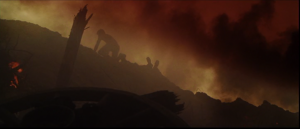For this exercise we are to find examples of non-diegetic sounds that have been used in various ways to enhance a film.
Diegetic sound used to convey meaning
In the shootout scene from Road to Perdition, where Sullivan shoots John Rooney and his gang, the audience is aware that this act is extremely difficult for Sullivan; it is effectively a choice between saving his son or saving Rooney. As Rooney and his gang leave the pub and walk to the cars, it is raining heavily and yet you do not hear any of the diegetic sound (rain, footsteps, cars, etc.), instead there is some very slow, soft and sad music playing. This music continues through the scene as Sullivan guns everyone down except Rooney – the audience sees where the bullets hit the gang and them going down, but no sounds of the machine gun. I think this is meant to show that these killings are slightly surreal for Sullivan, this is a necessary evil but not what he came to do – he is after Rooney.
After everyone except Rooney is dead, Sullivan walks up behind him. As Rooney turns and faces him, the music fades and for the first time you hear the sound of the rain. After they talk, Sullivan lifts his gun and fires repeatedly at Sullivan and this time – the audience hears the shots. This is the shooting that is real and pain for Sullivan – this is the part that cannot be wrapped up in music.
Non-diegetic sound that gives clues or cues to action
I think the most classic, memorable non-diegetic sound is the music from Steven Spielberg’s Jaws that was used to indicate that the shark was approaching. This sound is used throughout the film and the audience learns to associate the sound with a build of tension and approaching threat. This sound is so iconic that I have heard young children mimic this sound in a swimming pool to announce some imaginary danger (and they almost certainly have never seen Jaws). I have added a clip below. The non-diegetic sound I am referring to starts at about 1:34.
Sound that’s hard to identify as diegetic or non-diegetic
The opening scene of the film Cold Mountain shows the ‘lull before the storm’ of the 1894 siege of Petersburg. The scene starts off looking fairly calm however, a boy wheels a barrow up to collect something that he then transports elsewhere. There is a male voice that says in a strong southern drawl “This boy’s a long way from home” – it is not clear who says this. It may be a soldier in the scene who is sitting nearby but off screen, in which case the sound is diegetic but it may also be a voice over from someone – it is unclear. The background ‘music’ sounds like a slow sad hum.
Non-diegetic sound used to create atmosphere
In the same film, Cold Mountain, after the Yankees have blown up the trenches and many soldiers have died, the main character emerges from the rubble and sees the photo of his girlfriend burning. A young boy starts to crawl out of the devastation. All the while, there is music and a song in the background and the sentence – ‘I’ve gone to find my own true love’ . This love song played during the devastation of war only serves to remind the viewer of the tragedy of war and how it tears apart the concept of love.

Non-diegetic sound used to create tension
The shower scene from Alfred Hitchcock’s Pyscho is used to illustrate so many techniques in movie making – with it being one of the most quotes examples of the Kuleshov Effect and how viewers believe that they have seen the woman in the shower being stabbed when in fact that is never shown. However, this scene is also a great example of the use of diegetic and then non-diegetic sound to create unbearable tension. At the start the sound is all diegetic; the shower curtain being pulled and the water from the shower – this ‘silence’ plus the shadows through the shower curtain build the tension however as the shower is pulled back, the most awful, high-pitched repetitive sound is added – it is piercing and adds significantly to the audience experience of the horror that is happening in the shower.
Intentionally confusing diegetic and non-diegetic sound
The OCA work book for this course references Mel Brook’s Blazing Saddles as an example of intentionally leading the viewer to think that they are listening to non-diegetic sound i.e. the music score, however they soon realize that the music is diegetic as the rider approaches a rather bizarre band out in the desert playing. A highly amusing scene.
Exaggerated diegetic sounds with non-diegetic sound
In the next clip, from Hot Fuzz, there is a very confusing arrangement of sound that all serve to heighten the tension in the scene. The police officer standing on the platform needs to meet with someone at 15h00 however he is stuck presenting tombola prizes at the local village fete. As the tombola starts turning, he looks up at the church clock – the sound could be either thunder (although it looks clear) preempting the tragedy to come, an exaggerated ticking of the church clock or it could be the tombola.
As the scene continues, the non-diegetic sound of ‘evil’, something like an exhalation of breath is introduced as the murderer reaches the church roof. The tempo of scene is then increased with the introduction of music that at first sounds like Karl Orff’s Carmina Burana (it isn’t Carmina Burana but I don’t know what it is).
